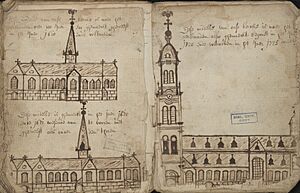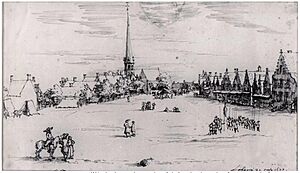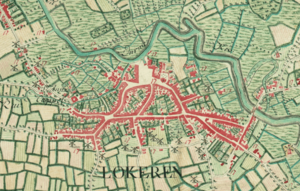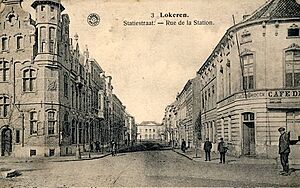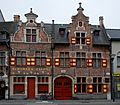Lokeren facts for kids
Quick facts for kids
Lokeren
|
|||
|---|---|---|---|
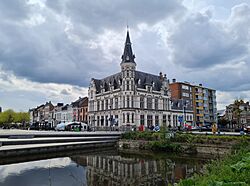
The Old Postoffice of Lokeren
|
|||
|
|||
| Country | Belgium | ||
| Community | Flemish Community | ||
| Region | Flemish Region | ||
| Province | East Flanders | ||
| Arrondissement | Sint-Niklaas | ||
| Area | |||
| • Total | 67.50 km2 (26.06 sq mi) | ||
| Population
(2018-01-01)Lua error in Module:Wd at line 1575: attempt to index field 'wikibase' (a nil value).
|
|||
| • Total | Lua error in Module:Wd at line 1,575: attempt to index field 'wikibase' (a nil value). | ||
| Postal codes |
9160
|
||
| Area codes | 09 | ||
| Website | www.lokeren.be | ||
Lokeren is a city and a municipality in East Flanders, a province in Belgium. It's part of a region called the Waasland, or Land van Waas. Lokeren is the second most important city in this area, after Sint-Niklaas.
The city is located by the Durme river and the Lede, and close to the E17 motorway. More than 42,100 people live in Lokeren. They are sometimes called Lokeraars or Rapenfretters. Because the Durme river flows through it, Lokeren is often known as "The Durme City". A special local food, horse sausages, is officially recognized as a regional product.
Contents
What Does the Name Lokeren Mean?
Some experts believe the name Lokeren comes from the word luken. This word means "to enclose" or "to close". So, Lokeren might have been a place enclosed between the Durme river and a forest where wild animals lived.
Another idea is that the name Lokeren comes from two older words. Leuk is an ancient word meaning "clear" or "shiny". Arna is a very old word for "water". This theory suggests Lokeren means "clear water". However, there's no old proof to fully support this idea.
A Look Back: Lokeren's History
How Lokeren Began
People have lived in the Lokeren area since the Neolithic Age, which was a very long time ago! A Roman road once ran along the Durme river. The Romans called this area "Waasland" because Wasu meant "marshy land" in an old Germanic language.
The name Lokeren was first written down in 1114. The new village was built on the right side of the Durme river. By the mid-1100s, it became its own parish. Farming and growing flax were the main ways people made a living. The textile industry, which uses flax, was very important here until the 1900s.
From the 1300s to the 1500s
Lokeren has always been connected to other towns by important roads. These roads helped the city grow and form its center. For many centuries, Lokeren was part of the County of Flanders. However, some parts of the city were owned by powerful local lords.
An important event in the 1200s was the start of a Cistercian nunnery called Oudenbos. The nuns from this monastery did a lot of work to clear land nearby. They owned these lands until the late 1700s. Other religious groups also owned land in the area during the Middle Ages.
The 1500s and 1600s: Challenges and Changes
In 1555, Emperor Charles V gave Lokeren the right to hold a market. This was a big deal for the city's trade. During the 1500s and 1600s, the Waasland region, including Lokeren, was caught in conflicts between the Protestant Netherlands and Catholic Spain. This caused a lot of hardship for the people. Many Lokeraars moved to the northern Netherlands.
Because so many people left, many farms were abandoned. This led to a serious problem with wolves in the 1600s! Over time, the city council bought land around the market square. By 1651, the market looked much like it does today, even having a small quay for boats. After 1700, Lokeren started to grow again, thanks to a new industry: hat making. Lokeren became famous around the world for its hats. The city was also a key area for flax, which was used to make linen, a major industry in Flanders for centuries.
The 1700s and 1800s: Growth and Industry
In the 1700s, Lokeren had more people than any other city in East Flanders, except for Ghent. This growth was due to a good economy. Trade by water also increased. To make shipping easier, a bend in the Durme river was cut off. The Ferraris map from around 1775 still shows this old river bend. In 1725, the Church of Saint Laurence was built in the market square.
In 1804, Napoleon Bonaparte officially made Lokeren a city. This was an important step for its development.
In 1845, the city decided to build a train station and a railway bridge over the Durme. This project helped create jobs after a bad harvest. The train station opened on August 7, 1847. It changed the look of Lokeren, especially with the new Stationsstraat (Station Street) leading to it. New neighborhoods were built on the left side of the Durme river.
Lokeren's industries grew rapidly in the 1800s. Many small workshops focused on traditional crafts like hat making and linen bleaching. This helped the city thrive until the early 1900s. Later, larger factories were built. However, by the end of the 1800s, other cities like Aalst and Sint-Niklaas started to become more important industrially.
The 1900s: Wars and Rebuilding
The First World War slowed Lokeren's growth, but the city was not badly damaged. During the Second World War, a transit camp was set up in Lokeren for English prisoners of war. After the war, this camp became a place to hold people who had worked with the enemy. It was one of the largest such centers, holding many thousands of people.
After the wars, Lokeren quickly rebuilt. Damaged houses were fixed, and the old train station was replaced with a new, modern one. Many bridges over the Durme and Lede rivers were also rebuilt. The city center expanded a lot, with new homes and industrial areas.
Modern Industry and City Expansion
Factories in the city center continued to operate until the 1980s. Then, it was decided that all industrial activities should move outside the city center. Many large factories closed down. New industrial areas were planned in places like Den Oever, Rozen, and Everslaar. A new freight train station was also built. In 2018, the famous chocolatier Callebaut bought a large piece of land in Everslaar to build one of Europe's biggest chocolate warehouses.
In the 1970s, railway lines that ran through the city center were raised onto a viaduct. This divided the center into three parts.
Between 1960 and 1980, Lokeren grew even more, especially to the north of the center. New neighborhoods were built. Later, the city expanded to the south, turning small villages like Spoele and Bokslaar into new neighborhoods. These areas now reach almost to the E17 motorway. The western part of the city also grew. Because of this growth, King Baudouin of Belgium visited Lokeren in 1956.
Since January 1, 1977, the nearby towns of Eksaarde and Daknam have become part of Lokeren. Daknam and Lokeren had actually been one administrative area since 1794.
Places to See in Lokeren
Lokeren has several interesting places to visit:
- You can find art galleries and a museum that shows the city's history, from ancient times to the mid-1900s.
- The Sint-Laurentius Church was built in 1725.
- Since 1956, the city has had a special musical instrument called a carillon with 49 bells.
- The Molsbroek is a beautiful nature area located in Lokeren.
- The front of the Sint-Lodewijks college, which is a high school, is also a notable sight.
Famous People from Lokeren
Many notable people have come from Lokeren, including:
- Jan van Lokeren, a sculptor (lived in the late 1300s)
- Hendrick de Somer, a painter (1602–1656)
- Joséphine Nyssens Keelhoff, an activist and social reformer (1833-1917)
- Frans Rens, a writer (1805–1874)
- Miet Smet, a politician (born 1943)
- Aimé Anthuenis, a former football player and coach (born 1943)
- Marleen Temmerman, a gynaecologist (born 1953)
- Willy Linthout, a comics author (born 1953)
- François Van Der Elst, a former international football player (born 1954)
- Chris Van den Durpel, an actor and imitator (born 1960)
- Paul Verhaeghen, a novelist (born 1965)
- Femke Maes, a former international football player (born 1980)
- Jelle Van Damme, a former international football player (born 1983)
- Linde Merckpoel, a radio presenter (born 1984)
- Greg Van Avermaet, a professional cyclist (born 1985)
- Killian Overmeire, a former international football player (born 1985)
- Lorca Van De Putte, a football player (born 1988)
- Manuel Benson, a football player (born 1997)
- Luka van den Keybus, a gymnast (born 1997)
- Tim Coppens, a fashion designer
Sports and Events in Lokeren
- The main football club in Lokeren is K.S.C. Lokeren Oost-Vlaanderen.
- Lokeren is famous in Flanders for its annual ten-day music festival and fair. It's called the Lokerse Feesten and happens in the first week of August.
Images for kids
See also
 In Spanish: Lokeren para niños
In Spanish: Lokeren para niños





